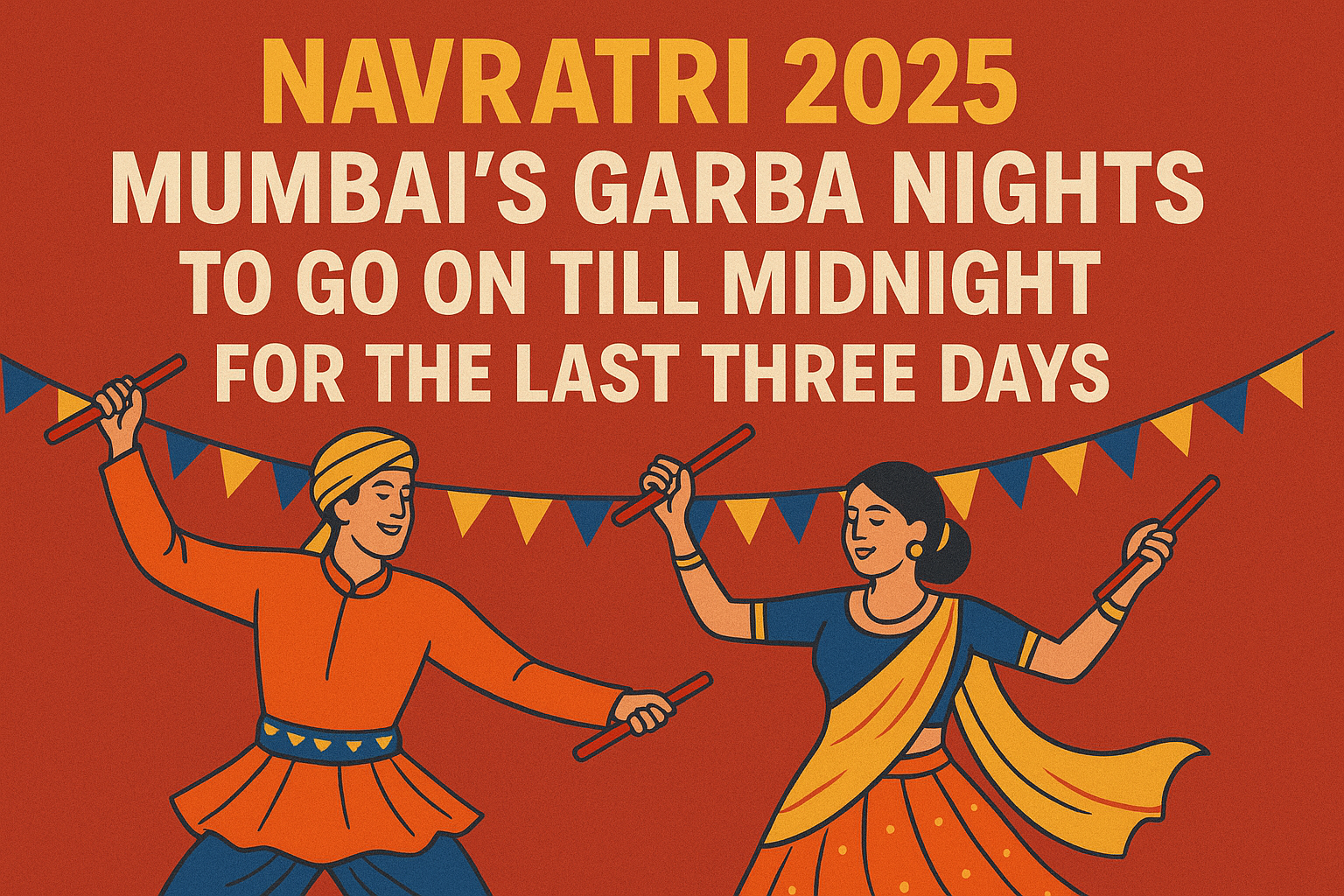
Navratri 2025: Mumbai’s Garba Nights to Go On Till Midnight for the Last Three Days
Navratri in Mumbai has always been more than just a festival—it’s an emotion. From the rhythmic beats of the dhol to the swirl of colourful ghagras and the sparkle of lights at pandals, the nine-day celebration is one of the city’s most awaited cultural highlights. This year, despite a damp start due to heavy rains and waterlogging in several parts of the city, devotees and dance enthusiasts have something to cheer about. The Mumbai District Collector’s Office has granted permission for loudspeakers and amplifiers to be used until 12 midnight on the last three days of Navratri—Saptami (September 29), Ashtami (September 30), and Navami (October 1).
For thousands of Mumbaikars who wait all year for Garba and Dandiya nights, this extension has come as a huge relief. Until now, music had been restricted to 10 pm, leaving organisers and participants disappointed. Many felt the restriction diluted the spirit of Navratri, a festival often associated with late-night dance circles and community gatherings. The new order, signed by Mumbai Suburban District Collector Saurabh Katiyar, restores the excitement by allowing extended hours, albeit with strict conditions.
What the New Order Means
According to the notification, loudspeakers can be used from 6 am to 12 midnight during the last three days. However, this does not mean a free hand for organisers. The use of sound systems will remain regulated under the Noise Pollution (Regulation and Control) Rules, 2000, and the Bombay High Court’s guidelines must be followed. Areas classified as silence zones, including hospitals, educational institutions, and courts, will remain exempt from the relaxation.
To ensure compliance, the Noise Authority has been empowered to take action under the Environment Protection Act, 1986, in case of violations. This means that while Mumbaikars can enjoy music and dance until midnight, any breach of the rules could result in penalties or legal proceedings against organisers. Collector Katiyar has also warned that permissions could be revoked if norms are not adhered to.
Why the Extension Matters
For Mumbai’s cultural enthusiasts, Navratri is not just about religious rituals; it is also about social bonding, community celebrations, and showcasing the city’s diversity. Large-scale Garba and Dandiya events attract participants across age groups—from school children dressed in vibrant attire to senior citizens reliving traditions.
This year’s extension is particularly significant because the first few days of the festival were overshadowed by heavy rainfall and flood concerns, which limited participation. With the weather expected to stabilise, the three-day extension offers a much-needed boost for organisers and devotees alike. Event managers are expecting a surge in attendance at open-air grounds and community halls across Mumbai and the suburbs.
Balancing Celebration and Responsibility
The move to extend timings reflects the government’s attempt to strike a balance between preserving cultural traditions and ensuring environmental responsibility. Noise pollution has long been a matter of concern in Mumbai, with multiple cases being filed in the past by residents disturbed by blaring speakers.
By setting clear boundaries—such as excluding silence zones and enforcing strict monitoring—the administration aims to allow festivities without compromising on public health and safety. Environmentalists, while supportive of cultural practices, continue to urge organisers to adopt sustainable measures such as soundproofing, controlled decibel levels, and eco-friendly decorations to reduce the impact on the city’s already stressed infrastructure.
The Spirit of Navratri in Mumbai
Despite challenges, Navratri in Mumbai retains its unique charm. From Borivali to Ghatkopar and Andheri to Thane, every corner of the city hosts its own version of Garba. Some pandals invite popular singers and DJs, while others focus on traditional live music. The energy, however, remains the same—families gathering together, young crowds forming circles of dance, and the city buzzing with life long after sunset.
The extension until midnight ensures that Mumbaikars can experience Navratri the way it is meant to be—filled with joy, colour, and community spirit. With stricter checks in place, the focus is now on responsible celebration, where tradition and modern regulations coexist.
Looking Ahead
As Mumbai embraces the festive mood, organisers are gearing up for record turnouts in the last three days. Hotels, local markets, and transport services are also expected to see a rise in activity, as Navratri celebrations often go hand in hand with food stalls, shopping, and late-night travel.
For many, the extension is more than just about music—it is about reclaiming the cultural space that was briefly restricted. With the beats of the dhol ready to echo into the night, Mumbai is set to experience Navratri in its full glory once again.
This year’s midnight Garba sessions will not only mark a festive comeback after the rains but also highlight the city’s resilience—its ability to dance through challenges and celebrate together, no matter the odds.





